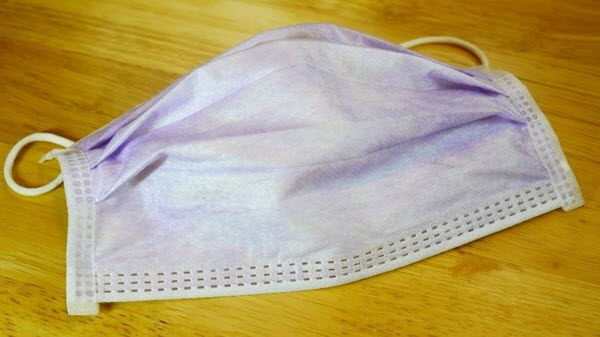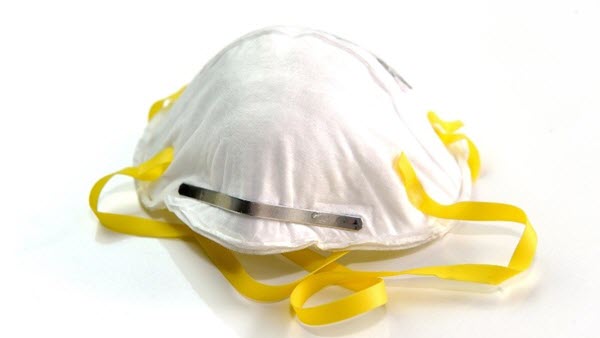
N95 respirators and surgical masks are examples of personal protective equipment that are used to protect the wearer from particles or from liquid contaminating the face. The Centers for Disease Control and Prevention (CDC) National Institute for Occupational Safety and Health (NIOSH) also regulates N95 respirators. The Department of Labor's Occupational Safety and Health Administration (OSHA) regulates entities for compliance with worker safety rules and OSHA standards, including, for example, the proper use of respirators in different work environments.
It is important to recognize that the optimal way to prevent transmission of microorganisms, such as viruses, is to use a combination of interventions from across the hierarchy of controls, not just PPE alone.
A face mask is a product that covers the wearer's nose and mouth. Face masks are for use as source control by the general public and health care personnel (HCP) in accordance with CDC recommendations, and are not personal protective equipment. Face masks may or may not meet any fluid barrier or filtration efficiency levels; therefore, they are not a substitute for N95 respirators or other Filtering Facepiece Respirators (FFRs), which provide respiratory protection to the wearer, or for surgical masks, which provide fluid barrier protection to the wearer.
A barrier face covering, as described in ASTM F3502-21, is a product worn on the face specifically covering at least the wearer's nose and mouth, with the primary purpose of providing source control and to provide a degree of particulate filtration to reduce the amount of inhaled particulate material. Barrier face coverings are not a substitute for N95 respirators and other Filtering Facepiece Respirators (FFRs), which provide respiratory protection to the wearer, or for surgical masks, which provide fluid barrier and particulate material protection to the wearer.
Barrier face coverings may be made from a variety of materials that are not flammable. By definition, a barrier face covering should meet the particulate filtration efficiency, airflow resistance, and leakage assessment recommendations as described in ASTM F3502-21.
A surgical mask is a loose-fitting, disposable device that creates a physical barrier between the mouth and nose of the wearer and potential contaminants in the immediate environment. Surgical masks are regulated under 21 CFR 878.4040. Surgical masks are not to be shared and may be labeled as surgical, isolation, dental, or medical procedure masks. They may come with or without a face shield. These are sometimes referred to as face masks, as described above, although not all face masks are regulated as surgical masks.
Surgical masks are made in different thicknesses and with different ability to protect you from contact with liquids. These properties may also affect how easily you can breathe through the face mask and how well the surgical mask protects you.
If worn properly, a surgical mask is meant to help block large-particle droplets, splashes, sprays, or splatter that may contain germs (viruses and bacteria), keeping it from reaching your mouth and nose. Surgical masks may also help reduce exposure of your saliva and respiratory secretions to others.
While a surgical mask may be effective in blocking splashes and large-particle droplets, a face mask, by design, it does not filter or block very small particles in the air that may be transmitted by coughs, sneezes, or certain medical procedures. Surgical masks also do not provide complete protection from germs and other contaminants because of the loose fit between the surface of the mask and your face.
Surgical masks are not intended to be used more than once. If your surgical mask is damaged or soiled, or if breathing through the mask becomes difficult, you should remove it, discard it safely, and replace it with a new one. To safely discard your surgical mask, place it in a plastic bag and put it in the trash. Wash your hands after handling the used mask.
An N95 respirator is a respiratory protective device designed to achieve a very close facial fit and very efficient filtration of airborne particles. Note that the edges of the respirator are designed to form a seal around the nose and mouth. Surgical N95 Respirators are commonly used in healthcare settings and are a subset of N95 Filtering Facepiece Respirators (FFRs), often referred to as N95s.
The FDA regulates surgical masks and surgical N95 respirators differently based on their intended use.

A surgical mask is a loose-fitting, disposable device that creates a physical barrier between the mouth and nose of the wearer and potential contaminants in the immediate environment. These are often referred to as face masks, although not all face masks are regulated as surgical masks. Note that the edges of the mask are not designed to form a seal around the nose and mouth.

An N95 respirator is a respiratory protective device designed to achieve a very close facial fit and very efficient filtration of airborne particles. Note that the edges of the respirator are designed to form a seal around the nose and mouth.
Surgical N95 Respirators are commonly used in healthcare settings and are a subset of N95 Filtering Facepiece Respirators (FFRs), often referred to as N95s.
Most N95 respirators are manufactured for use in construction and other industrial type jobs that expose workers to dust and small particles. They are regulated by the National Personal Protective Technology Laboratory (NPPTL) in the National Institute for Occupational Safety and Health (NIOSH), which is part of the Centers for Disease Control and Prevention (CDC).
However, some N95 respirators are intended for use in a healthcare setting. Specifically, single-use, disposable respiratory protective devices used and worn by healthcare personnel during procedures to protect both the patient and healthcare personnel from the transfer of microorganisms, body fluids, and particulate material. These surgical N95 respirators are class II devices regulated by the FDA, under 21 CFR 878.4040, and CDC NIOSH under 42 CFR Part 84.
N95s respirators regulated under product code MSH are class II medical devices exempt from 510(k) premarket notification, unless:
The FDA has a Memorandum of Understanding (MOU) with CDC NIOSH which outlines the framework for coordination and collaboration between the FDA and NIOSH for regulation of this subset of N95 respirators.
For additional differences between surgical masks and N95 respirators, please see CDC's infographic.